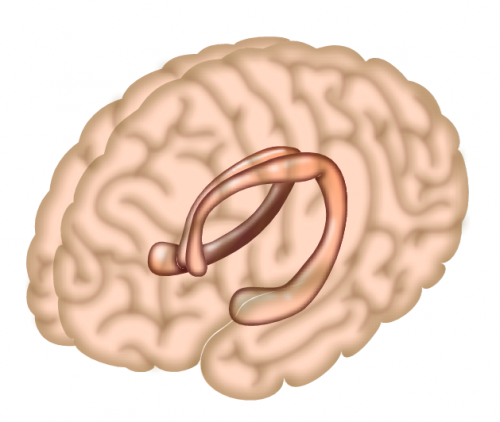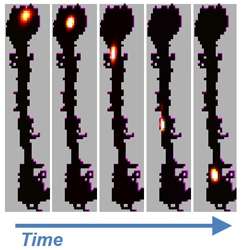July 13, 2015 report
Scientists study how memory patterns propagate in the hippocampus

(Phys.org)—Studying patterns of neuronal activity is difficult, and in the absence of in vivo data, scientists have relied on theoretical models to establish likely processes in the brain. In 1982, scientist John Hopfield proposed a framework for a recurrent artificial neural network, since named the Hopfield network. It describes an associative memory system comprising recurrently excitable neurons that store discrete memory patterns—these patterns are "attractors" to which partial patterns always converge, a process called autoassociation.
Neuroscientists have recognized that Hopfield networks provide a model of human memory, and a pair of researchers from Johns Hopkins University School of Medicine have published a study exploring the mechanisms of self-sustaining sequences of activity patterns in neuronal circuits. They've published their results in the journal Science.
They focused their research on rat place cells, hippocampal neurons that activate in response to an animal's location in its environment. The population of place cells in the hippocampus generates a cognitive map of the animal's surroundings, and they are capable of changing their firing patterns in response to a large change. But the patterns are believed to be stabilized by Hopfield network attractor dynamics.
The study provides evidence that hippocampal neurons express sequenced reactivations composed of the autoassociative "attractor" patterns that Hopfield described in his framework. Further, the researchers establish that sequences of patterns can be stored by combining fast autoassociation of attractors with slower so-called "heteroassociation" of successive patterns. This allows each pattern to be corrected before transitioning to the next pattern in the sequence.
Acquisition of direct evidence for these dynamics has been hindered in the past by the difficulty of obtaining data from large numbers of hippocampal cells, but the researchers recently developed techniques allowing them to record the activity of up to 263 neurons simultaneously. They recorded the activity of dorsal hippocampal neurons of five rats across multiple sessions during which the animals explored open areas and linear tracks.

One of the unresolved problems in theoretical models of such brain activity is the collapse of multiple networks of neural patterns into random noise. "It is recognized that unbounded attractor dynamics in such a network can lead to runaway excitatory activity," the authors write. "Our data suggests a solution to this problem, in which attractor strength oscillates at the slow-gamma frequency between high levels of activity [focusing neural representation on a "unit" of information, such as a single location in space] and low levels of activity [weakening the attractor dynamics to allow transition to another unit]."
Their findings regarding oscillations at the gamma frequency are consistent with a growing body of neuroscience suggesting that these slow rhythms mediate communication between brain regions by synchronizing signals from distant sources with local circuitry. "Our data point to an additional role in allowing neuronal architectures to focus representation while avoiding excess positive feedback," the authors write.
More information: "Autoassociative dynamics in the generation of sequences of hippocampal place cells." Science 10 July 2015: DOI: 10.1126/science.aaa9633
ABSTRACT
Neuronal circuits produce self-sustaining sequences of activity patterns, but the precise mechanisms remain unknown. Here we provide evidence for autoassociative dynamics in sequence generation. During sharp-wave ripple (SWR) events, hippocampal neurons express sequenced reactivations, which we show are composed of discrete attractors. Each attractor corresponds to a single location, the representation of which sharpens over the course of several milliseconds, as the reactivation focuses at that location. Subsequently, the reactivation transitions rapidly to a spatially discontiguous location. This alternation between sharpening and transition occurs repeatedly within individual SWRs and is locked to the slow-gamma (25 to 50 hertz) rhythm. These findings support theoretical notions of neural network function and reveal a fundamental discretization in the retrieval of memory in the hippocampus, together with a function for gamma oscillations in the control of attractor dynamics.
© 2015 Phys.org
















